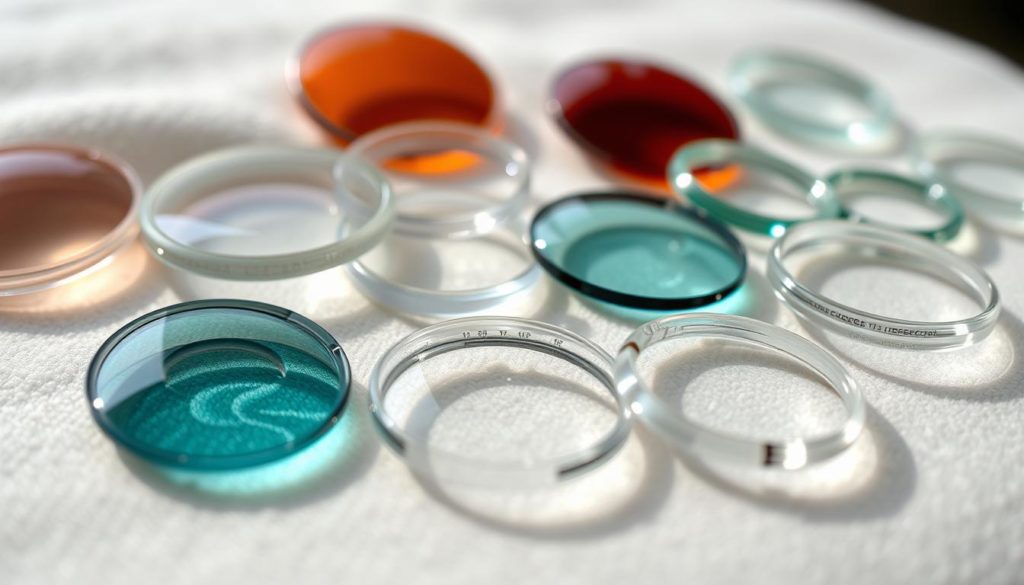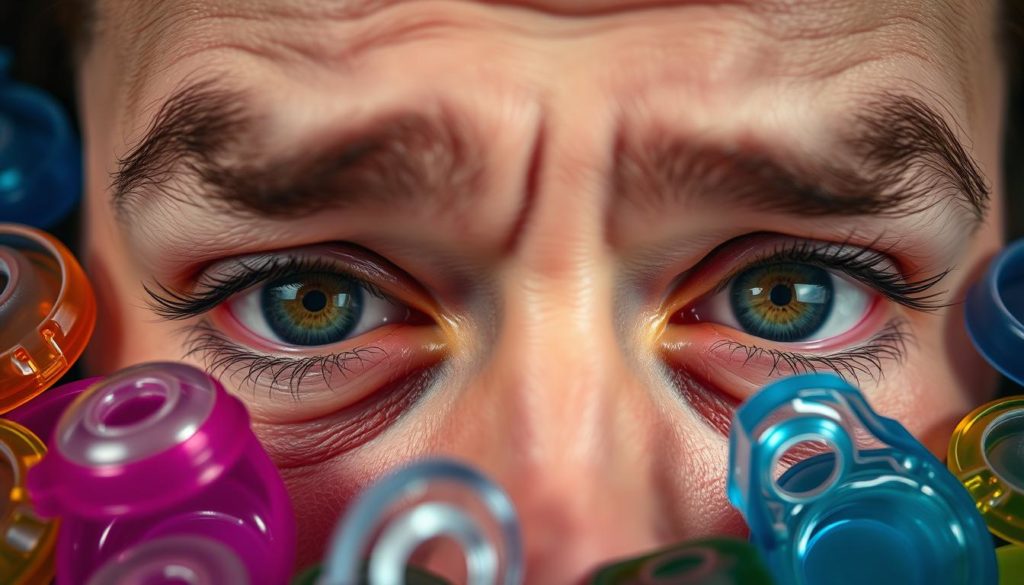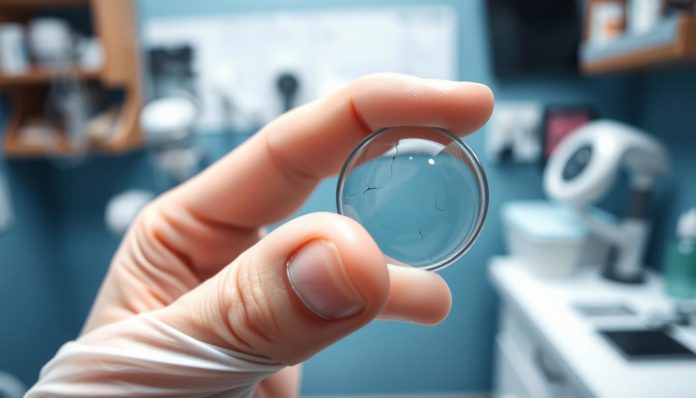Did you know 45 million Americans wear contact lenses? Yet, many face issues like irritation and discomfort. Finding good solutions for these problems is key for comfort and eye health.
Whether you’re new to lenses or have been wearing them for years, dealing with these issues can be tough. That’s why it’s important to know and use effective contact lens solutions.
In this guide, we’ll look at practical solutions for common contact lens problems. We’ll cover everything from finding out why you might be uncomfortable to how to prevent and fix issues. We aim to provide a detailed resource to help you overcome any lens-related challenges.
Understanding Common Contact Lens Problems
Contact lenses are a popular choice instead of glasses. But, many users face different issues. It’s key to know these common problems for a safe and comfy wear.
What Are Contact Lens Problems?
Common contact lens problems can be from minor irritations to serious issues. Symptoms include dry eyes, blurry vision, and discomfort. Spotting these problems early is crucial for quick and effective solutions.

Causes of Common Contact Lens Issues
There are many reasons for contact lens problems. Poor fit, not cleaning them right, allergies, and the environment are common causes. Each can lead to discomfort and other issues.
| Common Causes | Possible Solutions |
|---|---|
| Poor Lens Fit | Consult with an eye care professional to adjust the fit |
| Inadequate Cleaning | Follow proper cleaning routines and use recommended solutions |
| Allergies | Consider switching to hypoallergenic lenses |
| Environmental Factors | Use artificial tears and take frequent breaks |
Knowing the causes of contact lens problems helps users take steps to keep their eyes healthy. This way, they can enjoy the benefits of contact lenses safely.
Identifying Contact Lens Discomfort
Contact Lens discomfort is a common issue faced by many lens wearers. Being proactive in identifying the symptoms can help avoid further complications. There are several key signs to watch out for:

- Redness: If your eyes appear red or bloodshot, this could indicate irritation.
- Itchiness: Persistent itchiness can be a sign of an allergic reaction or dry eyes.
- Excessive tearing: Watery eyes may be a response to irritation or an improperly fitted lens.
- Foreign body sensation: A feeling that something is constantly in your eye, causing discomfort.
Recognizing these signs is crucial to maintaining eye health. Prolonged eye discomfort might lead to more severe issues if not addressed promptly. If you experience any of these symptoms, remove your lenses and consult with an eye care professional.
Understanding and identifying Symptom of Contact Lens Problems early on can help in taking timely action. Ensure your lens hygiene is impeccable and take regular breaks from contact lenses to prevent further discomfort.
Resolving Contact Lens Irritation
If you have Contact Lens irritation, finding the cause is key. It could be the lens material, dry eyes, or poor hygiene. Knowing this helps you find the right solution.
Diagnosis of Contact Lens Irritation
To figure out Contact Lens problems, start with self-checks and then see a doctor. Look for signs like redness, tearing, or burning. If these don’t go away, see an eye doctor. They can find the exact problem and suggest the right fix.
Ways to Alleviate Irritation
After finding the cause, it’s time to fix it. Here are ways to alleviate eye irritation:
- Use lubricating eye drops: These keep your eyes moist and comfy. Choose drops made for contact lens users.
- Take breaks: Remove your lenses often, especially when staring at screens for hours.
- Ensure correct hygiene practices: Clean your lenses right and replace them as advised. Poor hygiene can make irritation worse.
By doing these things, you can make your contact lenses comfortable again. They should help you see clearly without any pain.
| Actions | Benefits |
|---|---|
| Lubricating Eye Drops | Moistens eyes, reduces dryness |
| Regular Breaks | Prevents eye strain and discomfort |
| Proper Hygiene | Prevents infections and irritation |
Use these tips to fix Contact Lens irritation and keep your eyes healthy.
Preventing Contact Lens Infections
Keeping your contact lenses clean is key to avoiding eye infections. Many people get infections because they don’t follow good hygiene. Knowing the common infections and their signs can help you stay safe.
Common Infections and Symptoms
Wearing contact lenses can lead to infections like bacterial or fungal keratitis and conjunctivitis. These infections show signs that you should not ignore. For example, bacterial keratitis causes pain, redness, and discharge. Fungal keratitis makes your vision blurry and feels like something is in your eye. Conjunctivitis makes your eyes red, itchy, and gritty.
Prevention Measures
To lower the chance of getting an infection, follow these steps:
- Always wash your hands before touching your lenses for clean contact lens hygiene.
- Don’t let water touch your lenses to avoid harmful germs.
- Clean and replace your lens case often and use the right disinfectant.
- Change your lenses as your eye doctor advises.
By taking these steps, you can keep your eyes healthy and avoid seriouscontact lens infection.
Contact Lens Troubleshooting Tips
Having trouble with your contact lenses? We’ve got quick solutions to help you fix common problems. Here are some useful tips to tackle issues like mild discomfort, lens slippage, and foggy vision:
- Mild Discomfort: For mild discomfort, rinse your lenses with a multipurpose solution. Look for any debris or tears before putting them back in.
- Lens Slippage: To stop lenses from slipping, make sure they fit right. Gently move your eye to adjust the lens.
- Foggy Vision: Foggy lenses can be fixed by cleaning them well. Always wash your hands before touching your lenses.
Knowing these quick fixes can save you time and make wearing contact lenses more comfortable. By following these tips, you can enjoy your lenses without frequent visits to the eye doctor.
| Common Issue | Quick Fix | Additional Tips |
|---|---|---|
| Mild Discomfort | Rinse with solution, check for debris | Use moisturizing drops |
| Lens Slippage | Ensure correct fit | Check lens placement |
| Foggy Vision | Clean thoroughly | Keep hands clean |
Proper Contact Lens Care Tips
It’s crucial to take good care of your contact lenses for your eye health. We’ll share Contact Lens care tips on cleaning and care. Also, we’ll talk about why Eye Hygiene is so important.
Cleaning Your Contact Lenses
Cleaning your lenses regularly is key to avoiding infections and making them last longer. Here’s how to do it right:
- First, wash your hands with soap and water before touching your lenses. Dry them with a clean towel.
- Use only the contact lens solution recommended by your eye doctor. Never use tap water or spit.
- Gently rub your lenses with your fingers and then rinse them with solution to get rid of dirt.
- Soak your lenses in a clean case filled with fresh solution every night.
Importance of Hygiene
Good eye hygiene is crucial to avoid problems with contact lenses. Here are more Contact Lens care tips to keep your lens care routine on track:
- Don’t wear your lenses longer than your eye doctor says it’s okay.
- Change your contact lens case every three months to avoid germs.
- Don’t sleep in your lenses unless your eye doctor says it’s okay. It can lead to infections.
- If you feel pain or see signs of infection like redness or swelling, take out your lenses and see your eye doctor.
By following these Cleaning Contact Lenses and hygiene tips, you can enjoy wearing contact lenses safely and comfortably.
| Contact Lens Care Step | Description |
|---|---|
| Hand Washing | Wash and dry hands before handling lenses |
| Proper Solution | Use recommended contact lens solution only |
| Daily Cleaning | Rub and rinse lenses to remove buildup |
| Overnight Soaking | Immerse in fresh solution in a clean case |
| Case Replacement | Replace lens case every three months |
| Consulting an Eye Care Provider | See a professional if experiencing discomfort |
Solutions for Persistent Contact Lens Problems
Dealing with persistent contact lens problems can be frustrating. But, there are several long-term solutions that can improve comfort and vision. One solution is to explore different lens materials. Switching to newer, more advanced materials like silicone hydrogel can reduce dryness and irritation.
“Silicone hydrogel lenses allow more oxygen to reach the eye, enhancing comfort and overall eye health.”
Another effective approach is to consider updating your prescription. Even a small change in your lens power or fit can address chronic contact lens issues. Regular eye exams are crucial for ensuring your prescription is always up-to-date.
For chronic contact lens issues, some individuals find relief by switching to daily disposable lenses. These single-use lenses eliminate the need for cleaning solutions and reduce the risk of infection. Alternatively, exploring other forms of vision correction like LASIK surgery might offer a permanent solution.
- Switch to silicone hydrogel lenses
- Update your prescription regularly
- Try daily disposable lenses
- Consider alternative vision correction methods like LASIK
Addressing persistent contact lens problems requires the right products and regular professional advice. By exploring these options, you can find a solution that offers greater comfort and fewer issues with your contact lenses.
Why Regular Eye Check-ups Are Important
Keeping your eyes healthy is key, especially if you wear contact lenses. Regular eye exams help prevent vision problems and catch issues early. They offer personalized advice to meet your eye care needs.
This approach helps avoid long-term eye damage. It ensures your contact lenses don’t harm your eyes. Getting professional advice is crucial for the right fit and comfort.
Benefits of Professional Advice
Seeing an optometrist for a contact lens exam has many benefits. It includes a detailed eye health check. This can spot problems like dry eye, infections, or glaucoma early.
Experts also teach you how to use and care for your lenses safely. This reduces the chance of irritation or infection. They can also suggest lenses that fit your lifestyle and vision needs better.
When to See an Eye Doctor
Knowing when to visit an eye doctor is vital for contact lens users. While yearly exams are advised, seek immediate help for redness, discomfort, blurred vision, or discharge. These signs may indicate a serious issue that needs quick attention.
Eye exams are not just for vision. They are key to your eye health. Regular visits and knowing when to seek help protect your vision for life.
FAQ
What are the common contact lens problems?
Common problems include dry eyes, blurry vision, and discomfort. These can come from a bad fit, not cleaning them well, allergies, or the environment.
How can I identify contact lens discomfort?
Look for signs like redness, itchiness, and too much tearing. A feeling like something’s in your eye is also a sign. Catching these early can help fix the issue fast.
What causes contact lens irritation?
Irritation can come from not cleaning them right, wearing them too long, allergens, or the wrong solution. Finding the cause helps find a solution.
How can I alleviate contact lens irritation?
Use eye drops to lubricate, take breaks, and keep them clean. If it doesn’t get better, see an eye doctor.
What are the common infections from contact lenses and their symptoms?
Bacterial conjunctivitis and keratitis are common. Look out for redness, pain, too much tearing, and blurry vision. If you see these, get help right away.
How can I prevent contact lens infections?
Prevent infections by following good care, avoiding water, and washing hands before touching lenses. These steps can really help.
What are some quick fixes for common contact lens problems?
For mild discomfort, use re-wetting drops. For slipping, adjust the lens. Clean lenses to avoid fog. These simple steps can help a lot.
What is the importance of proper contact lens care?
Good care prevents infections and irritation. It also keeps lenses working well. Always clean, store, and replace them right.
How can I solve persistent contact lens problems?
For ongoing issues, try new lens materials or update your prescription. Sometimes, you need a professional to find the right solution.
Why are regular eye check-ups important for contact lens wearers?
Regular check-ups keep your eyes healthy and your prescription current. They help catch problems early. It’s key for your vision and comfort.
When should I see an eye doctor?
See a doctor for ongoing discomfort, redness, pain, or vision changes. Schedule yearly check-ups or as your doctor advises.


